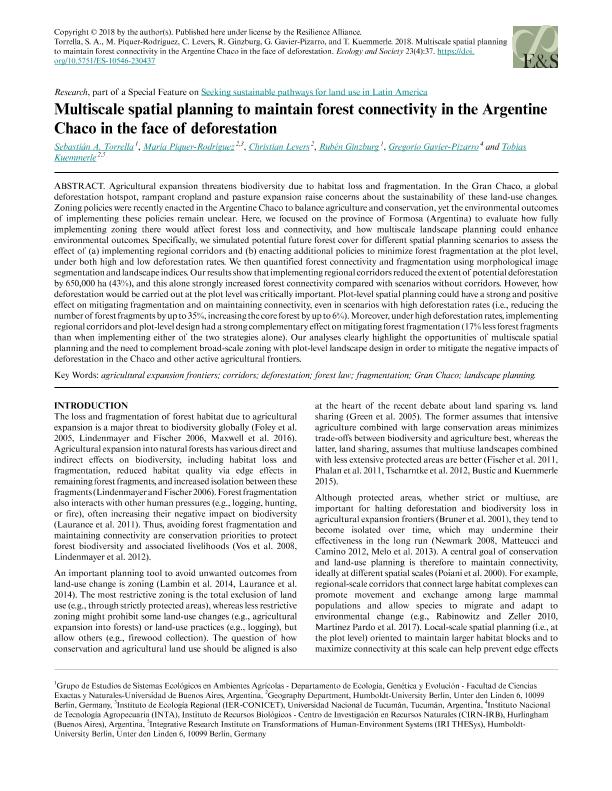Artículo
Multiscale spatial planning to maintain forest connectivity in the Argentine Chaco in the face of deforestation
Torrella, Sebastián Andrés; Piquer Rodríguez, María; Levers, Christian; Ginzburg, Rubén Gabriel; Gavier Pizarro, Gregorio ; Kuemmerle, Tobias
; Kuemmerle, Tobias
 ; Kuemmerle, Tobias
; Kuemmerle, Tobias
Fecha de publicación:
12/2018
Editorial:
Resilience Alliance
Revista:
Ecology and Society
ISSN:
1708-3087
e-ISSN:
1708-3087
Idioma:
Inglés
Tipo de recurso:
Artículo publicado
Clasificación temática:
Resumen
Agricultural expansion threatens biodiversity due to habitat loss and fragmentation. In the Gran Chaco, a global deforestation hotspot, rampant cropland and pasture expansion raise concerns about the sustainability of these land-use changes. Zoning policies were recently enacted in the Argentine Chaco to balance agriculture and conservation, yet the environmental outcomes of implementing these policies remain unclear. Here, we focused on the province of Formosa (Argentina) to evaluate how fully implementing zoning there would affect forest loss and connectivity, and how multiscale landscape planning could enhance environmental outcomes. Specifically, we simulated potential future forest cover for different spatial planning scenarios to assess the effect of (a) implementing regional corridors and (b) enacting additional policies to minimize forest fragmentation at the plot level, under both high and low deforestation rates. We then quantified forest connectivity and fragmentation using morphological image segmentation and landscape indices. Our results show that implementing regional corridors reduced the extent of potential deforestation by 650,000 ha (43%), and this alone strongly increased forest connectivity compared with scenarios without corridors. However, how deforestation would be carried out at the plot level was critically important. Plot-level spatial planning could have a strong and positive effect on mitigating fragmentation and on maintaining connectivity, even in scenarios with high deforestation rates (i.e., reducing the number of forest fragments by up to 35%, increasing the core forest by up to 6%). Moreover, under high deforestation rates, implementing regional corridors and plot-level design had a strong complementary effect on mitigating forest fragmentation (17% less forest fragments than when implementing either of the two strategies alone). Our analyses clearly highlight the opportunities of multiscale spatial planning and the need to complement broad-scale zoning with plot-level landscape design in order to mitigate the negative impacts of deforestation in the Chaco and other active agricultural frontiers.
Archivos asociados
Licencia
Identificadores
Colecciones
Articulos(SEDE CENTRAL)
Articulos de SEDE CENTRAL
Articulos de SEDE CENTRAL
Citación
Torrella, Sebastián Andrés; Piquer Rodríguez, María; Levers, Christian; Ginzburg, Rubén Gabriel; Gavier Pizarro, Gregorio; et al.; Multiscale spatial planning to maintain forest connectivity in the Argentine Chaco in the face of deforestation; Resilience Alliance; Ecology and Society; 23; 4; 12-2018; 1-19
Compartir
Altmétricas



